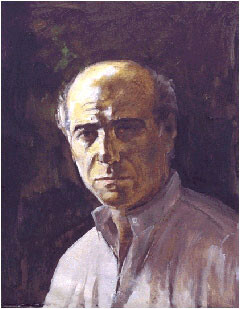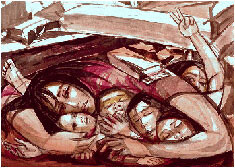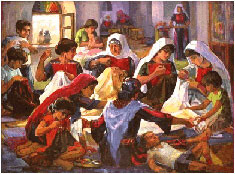The Electronic Intifada 5 July 2006

“The Olive Tree”, 2005
Ismail Shammout died July 4. How painful that Palestine was not there around his bed; but all he worked for our lives.
Born in Al-Lydd in 1931, Ismail Shammout had the good fortune as a youth to study with Dahoud Zalatimo. Remarkably, at the age sixteen he persuaded his reluctant father that he could earn a living making art. His father, even more amazingly, provided him with materials and a space to work. It was then 1947, only one year before the Nakbe.

“Self Portrait”, 1985
Shammout’s career as an artist and popular hero of Palestine began with his 1953 exhibition of oil paintings in Gaza of the catastrophic march through wilderness. The exhibited paintings objectify and socialize a pain that had simmered on a private level. Refugees in Gaza saw themselves reflected in Shammout’s work and felt relief. An immense attendance of the general population in Gaza, including those living in refugee camps, overwhelmed Shammout, then studying in Egypt. This stunning response to the show was a hint of the bottled up hope for liberation. In response, Shammout committed his life’s work to Palestine and the art of liberation.
His life and that of his wonderful wife Tamam Al-Akhal, spiraled around Palestine. With every move forced on them by Zionist aggression, they relocated somewhere not far from the center of their love. This denied center of the heart, Palestine, was finally visited years after the Nakbe. Of the many people who remember this visit, a most touching one was a description of Shammout meeting with Zalatimo, his first teacher and inspiration. In June of 2002, Fadwa Zalatimo, daughter of the great artists Dahoud Zalatimo, said to me that when Zalatimo was near death, 47 years after their involuntary separation, Shammout traveled to Jerusalem to visit Zalatimo. She remembers it as an event of great emotion. “It was mutual admiration between them,” said Fadwa. “They — Ismail and Zalatimo — met after the long separation. He [Shammout] kissed his hands and thanked him and they both cried.”

“Tel Al-Zaater 1976, in Shelter”, 1976

“For the Coming Joy”, 1987
Shammout’s studio was the place we went to as one goes to the source, a wealth of information and documents, a place of quiet, a place for thought and art, a place of gentleness, and above all a cultural storehouse of Palestine. Shammout is the builder of the Union of Palestinian artists, the builder of international exhibitions, the builder of young artists, the builder of galleries, and not least of all the historian of the liberation movement of Palestinian art.
He lives in my memories as that tall young man with intense eyes whom I first met in 1979 on the streets of Beirut. An image of night black hair flying in its own revolution impressed visually his intense message on my thourghts. Now that he is gone, the burden of his legacy weighs on all Palestinian artists, as we too shoulder the art and culture of Palestine, though we are scattered and suffering news of the latest attacks on Shammout’s Gaza.
Related Links
Samia Halaby is a Palestinian artist based in the US





